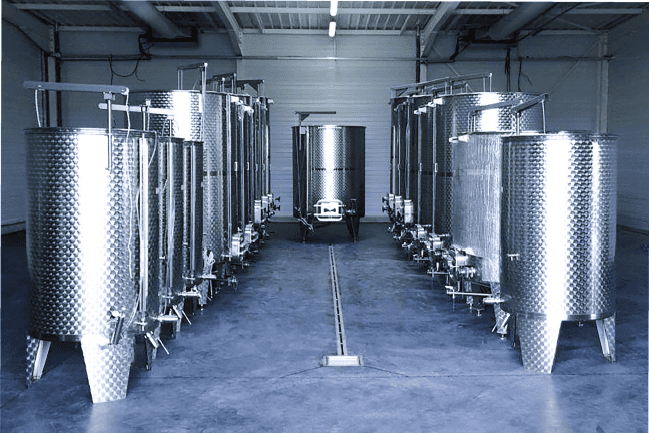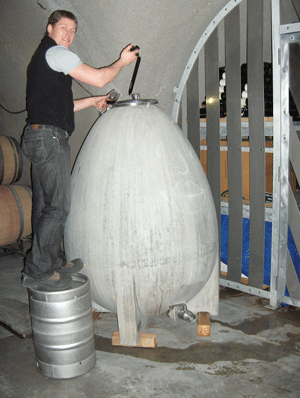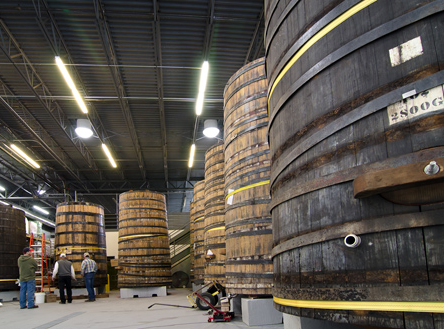Wine geeks are always talking about oak barrels (French? American? Slavonian?), stainless steel tanks, cement eggs, clay amphorae, and other vessels that only dorks care about.
But how does this make a difference in the wine that's in your glass?
Stainless Steel vs Oak vs Concrete & Clay
Oak (especially new oak) and stainless steel are on opposite sides of the spectrum, while concrete and clay offer a happy medium...
Stainless Steel
- Helps preserve freshness and acidity (this is why it's so popular for crisp white and rose production)
- Provides neutral vinification environment, so (unlike new oak) there's no external aromas/flavors integrated into the wine
- It's airtight meaning no oxygen can permeate into the vessel
- Without external flavors or oxygen-influence being imparted to the wine, purity and expression of the grape variety itself are key here
- Think primary characteristics: fruits, flowers, herbs, minerality
Stainless Steel

Will you geek out with me??? Get this loud delivered to your inbox! Max 1 email per week
Oak
- Depending on the type of oak, certain flavors may be imparted into the wine
- New Oak typically imparts flavors and aromas of: vanilla, clove, nutmeg, cinnamon, coconut, butterscotch, toast, cedar, charred wood (the barrel itself is literally charred wood), smoke, cocoa, coffee, and anything else similar to this lexicon.
- Oak is porous and not airtight, allowing oxygen to penetrate the vessel and interact with the wine
- Facilitates Malolactic Fermentation (MLF), giving the wine a creamy mouthfeel
- These characteristics are known as Secondary Aromas and Flavors
- New oak vs old oak: the newer the barrel the more it will impart toasty/vanilla/coconut/baking spice notes

New Oak

Concrete and Clay
- Happy medium between stainless steel and oak (which are on opposite ends of the spectrum)
- Similar porosity to oak, allowing oxygen to interact with the wine, but concrete does not impart flavors onto the wine as oak does
- Concrete is great for winemakers who want to preserve varietal purity, while also allowing oxygen and the wine to dance together, softening acidity and tannins
- Large tanks are most common, although concrete eggs are gaining popularity
- The egg-shape is beneficial because it keeps the grape skins, seeds, stems, etc in subtle motion as it provides a consistent flow of gravity within the vessel
- Clay vessels are virtually the same as concrete, allowing for oxygen interaction without imparting external flavors


Clay vats/amphorae

Like dorky stuff for dorks by dorks?!?! Get this sh*t delivered to your inbox.
French Oak vs American Oak
- The main difference is density
- French Oak
- Tends to be more dense, imparting less oaky characteristics and allows for less oxygen to permeate the barrel
- Better suited for elegant wines that need subtlety
- American Oak
- Less dense. Imparts more oaky characteristics and allows more oxygen integration
- Better suited for big bold wines (i.e. Napa Cabernet Sauvignon)
Shape
From the popular cylindrical tanks to eggs, spheres, and barrel-shaped vessels, the vessel's shape can affect the style and quality of a wine in multiple ways.
The vessel shape can increase (or decrease) the skin contact surface, modifying the extraction & color of the wine. While more extraction (think: steeping) leads to denser, more flavorful, darker, and tannic wines, a subtler contact can lead to gentler, more nuanced, and refined style.
Also, the shape directly impacts how much oxygen gets in contact with the wine during aging, affecting the tannin integration & texture of the wine.
On top of that, the shape and size of a tank regulate the temps and the aromatic expression and purity of the wine.
Size Matters
On opposite ends of the spectrum you have a smaller barrels called, "Barrique" and larger barrels called, "Foudre"
- Barrique: 225 liters (59 gallons)
- Foudre: anywhere between 2,000-12,000 liters (528-3,000) gallons
Smaller barrels intervene with the wine more as they allow more of the wine's surface area to be in direct contact with the wood. Large foudre provide less intervention as less of the wine's surface area is in contact with the wood. So old used foudre is a great choice for winemakers who want oxygenation of their wine and perhaps a very subtle chef's kiss of oak character.

What you taste in the glass is directly influenced by the shape, size, and material of a fermentation or maturity vessel.
Like what you're reading? Get this sent straight to your inbox! CLICK HERE.

Thank you for sharing your insights! It’s magnificent to hear various views on the effect of fermentation vessels in winemaking.
Fascinating read! Your insights into the influence of fermentation vessels on wine are enlightening. The depth of understanding showcased right here is surely commendable. Cheers to nice content!